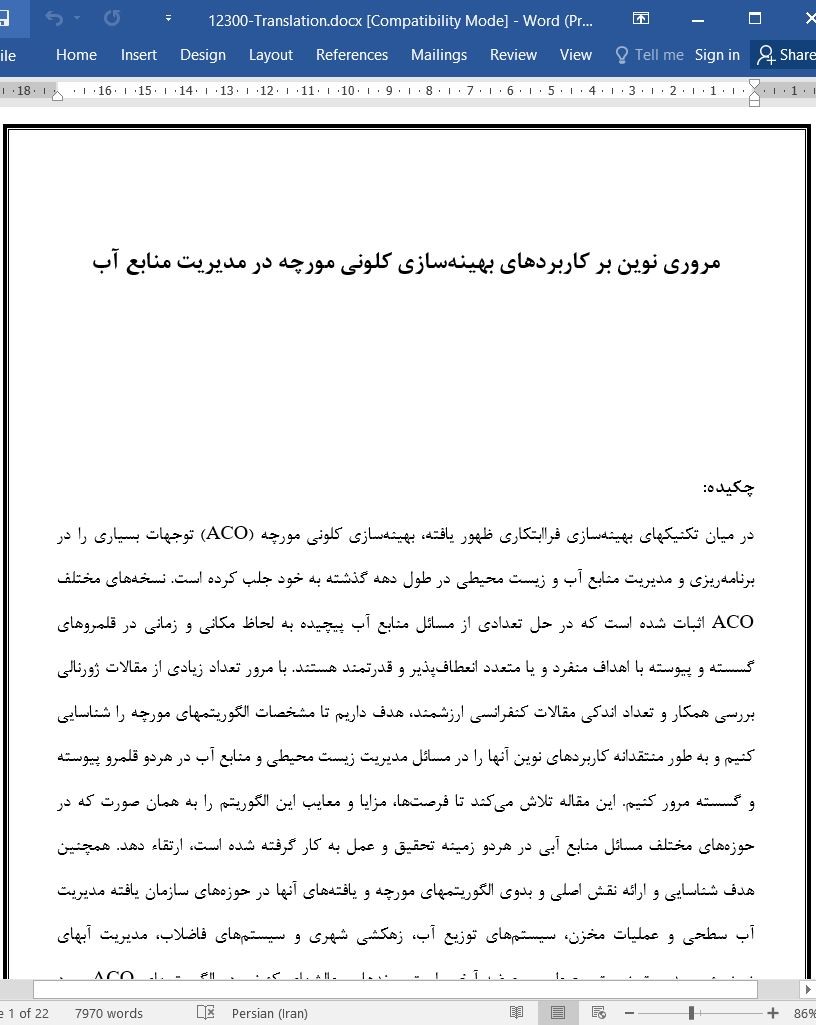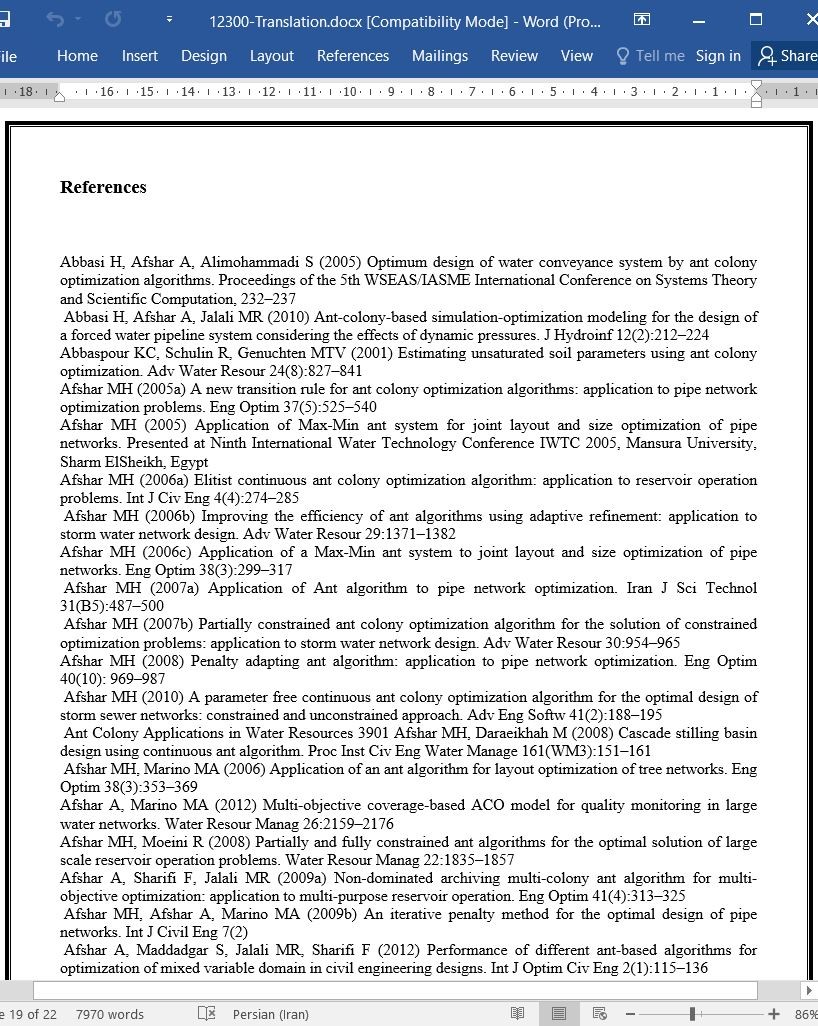
مروری نوین بر کاربردهای بهینه سازی کلونی مورچه در مدیریت منابع آب
چکیده
در میان تکنیکهای بهینه سازی فراابتکاری ظهور یافته، بهینه سازی کلونی مورچه (ACO) توجهات بسیاری را در برنامه ریزی و مدیریت منابع آب و زیست محیطی در طول دهه گذشته به خود جلب کرده است. نسخه های مختلف ACO اثبات شده است که در حل تعدادی از مسائل منابع آب پیچیده به لحاظ مکانی و زمانی در قلمروهای گسسته و پیوسته با اهداف منفرد و یا متعدد انعطاف پذیر و قدرتمند هستند. با مرور تعداد زیادی از مقالات ژورنالی بررسی همکار و تعداد اندکی مقالات کنفرانسی ارزشمند، هدف داریم تا مشخصات الگوریتمهای مورچه را شناسایی کنیم و به طور منتقدانه کاربردهای نوین آنها را در مسائل مدیریت زیست محیطی و منابع آب در هردو قلمرو پیوسته و گسسته مرور کنیم. این مقاله تلاش می کند تا فرصت ها، مزایا و معایب این الگوریتم را به همان صورت که در حوزه های مختلف مسائل منابع آبی در هردو زمینه تحقیق و عمل به کار گرفته شده است، ارتقاء دهد. همچنین هدف شناسایی و ارائه نقش اصلی و بدوی الگوریتمهای مورچه و یافته های آنها در حوزه های سازمان یافته مدیریت آب سطحی و عملیات مخزن، سیستم های توزیع آب، زهکشی شهری و سیستم های فاضلاب، مدیریت آبهای زیرزمینی، مدیریت زیست محیطی و حوضه آبخیر است. روندها و چالشهای کنونی در الگوریتمهای ACO مورد بحث قرار گرفتند و برای افزایش تلاش ها جهت انجام آنالیز همگرایی همانند در حوزه فعال مورد علاقه فراخوانی شدند.
1-مقدمه
با افزایش پیچیدگی زمانی و مکانی مسائل زیست محیطی و مدیریت منابع آب، کاربرد الگوریتمهای فراابتکاری به طور ناگهانی افزایش می یابد. از زمان معرفی ACO (دوریگو و همکاران، 1996)، نسخه ها و اصلاحات مختلف برای الگوریتم مورچه اصلی پیشنهاد شدند و برای حل مسائل متعدد در منابع آب و مدیریت زیست محیطی مورد استفاده قرار گرفتند. اوستفلد (2011) یک مقاله بازبینی درباره ACO برای آنالیز سیستم های منابع آب ارائه کرده است. اگرچه تلاش او تحسین برانگیز بود، اما به طور کامل به پیشرفتهای انجام شده در ACO با اهداف پیوسته و متعدد ، کاربردهای گسترده اخیر نسخه های مختلف ACO و افزایش همگرایی ها آنها و مقابله آنها با قیود نپرداخته است.
6- روندهای کنونی در ACO
در حالیکه کارایی الگوریتمهای ACO و درک تئوریکی ما از کار آنها به طور فزآینده افزایش یافته است، چندین حوزه وجود دارند که در آنها تنها گامهای مقدماتی برداشته شدند و تحقیقات زیادی نیاز است تا انجام شوند. بسط الگوریتمهای ACO برای مسائل بهینه سازی بیشتر پیچیده همانند مسائل دینامیک، مسائل تصادفی و مسائل چند هدفه به نظر می رسد که اولین حوزه باشد. دیگر جهت گیریهای تحقیقاتی فعال در ACO شامل موازی سازی موثر الگوریتم های ACO و درک و تعیین رفتار الگوریتمهای ACO و همگرایی های آنها در هنگام حل یک مسئله نوین هستند (دوریگو و استاتلز، 2004).
Abstract
Among the emerged metaheuristic optimization techniques, ant colony optimization (ACO) has received considerable attentions in water resources and environmental planning and management during last decade. Different versions of ACO have proved to be flexible and powerful in solving number of spatially and temporally complex water resources problems in discrete and continuous domains with single and/or multiple objectives. Reviewing large number of peer reviewed journal papers and few valuable conference papers, we intend to touch the characteristics of ant algorithms and critically review their state-of- the-art applications in water resources and environmental management problems, both in discrete and continuous domains. The paper seeks to promote Opportunities, advantages and disadvantages of the algorithm as applied to different areas of water resources problems both in research and practice. It also intends to identify and present the major and seminal contributions of ant algorithms and their findings in organized areas of reservoir operation and surface water management, water distribution systems, urban drainage and sewer systems, groundwater managements, environmental and watershed management. Current trends and challenges in ACO algorithms are discussed and called for increased attempts to carry out convergence analysis as an active area of interest.
1 Introduction
As the spatial and temporal complexity of the water resources management and environmental problems increases, application of metaheuristic algorithms extends dramatically. Since the introduction of ACO (Dorigo et al. 1996), Different versions and refinements to the original ant algorithm are proposed and applied to solve various problems in water resources and environmental management. Ostfeld (2011) presented a review paper on ACO for water resources systems analysis. Although his attempt is acknowledged, it does not fully address the advances made in continuous and multiple objective ACO, recent wide range applications of different versions of ACO, and the enhancements in their convergences and constraint handlings.
6 Current Trends in ACO
While both the performance of ACO algorithms and our theoretical understanding of their working have significantly increased, there are several areas in which only preliminary steps have been taken and much more research are to be done. Extension of ACO algorithms to more complex optimization problems such as (1) dynamic problems, (2) stochastic problems, and (3) multiple objective problems is known to be the first area. Other active research directions in ACO include the effective parallelization of ACO algorithms and understanding and characterization of the behavior of ACO algorithms and their convergences while solving a novel problem (Dorigo and Stutzle 2004).
چکیده
1-مقدمه
2- بهینه سازی کلونی مورچه؛ مرور
3- الگوریتم های کلونی مورچه پیوسته
4- ACO اهداف متعدد
5- کاربرد الگوریتمهای ACO در مدیریت منابع آب (WRM)
5-1- مدیریت عملیات مخزن و آب سطحی
5-2- سیستم توزیع آب
5-3- زهکشی شهری و سیستم فاضلاب
5-4- مدیریت آب زیرزمینی
5-5- مدیریت زیست محیطی و حوضه آبخیز
5-6- کاربردهای دیگر
6- روندهای کنونی در ACO
منابع
Abstract
1 Introduction
2 Ant Colony Optimization; an Overview
3 Continuous Ant Colony Algorithms
4 Multiple Objectives ACO
5 Application of ACO Algorithms in Water Resource Management (WRM)
5.1 Reservoir Operation and Surface Water Management
5.2 Water Distribution System
5.3 Urban Drainage and Sewer System
5.4 Groundwater Managements
5.5 Environmental and Watershed Management
5.6 Other Applications
6 Current Trends in ACO
References
- اصل مقاله انگلیسی با فرمت ورد (word) با قابلیت ویرایش
- ترجمه فارسی مقاله با فرمت ورد (word) با قابلیت ویرایش، بدون آرم سایت ای ترجمه
- ترجمه فارسی مقاله با فرمت pdf، بدون آرم سایت ای ترجمه


